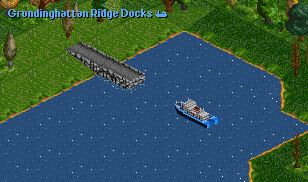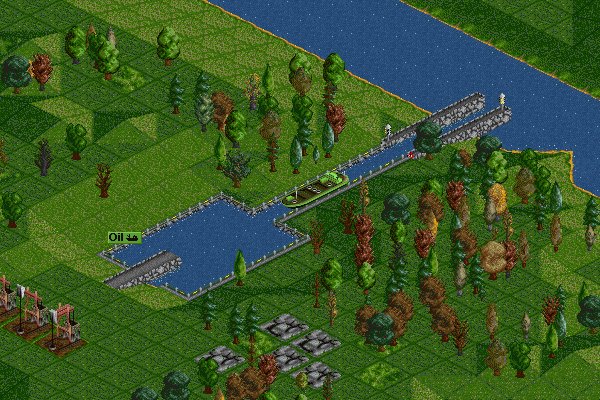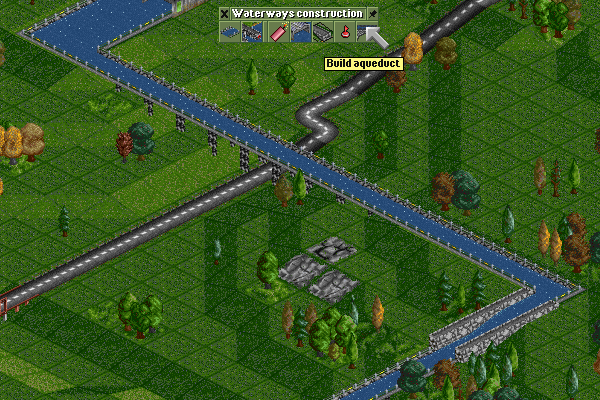This article is about Docks, buoys, canals and locks. To learn how to build docks, see Building docks
Contents |
Docks

A MPS Passenger Ferry using a dock in OpenTTD
 Docks are the loading and unloading stations for ships and ferries. They can be built on any coastline that is straight and not diagonal. Docks have a coverage range of five tiles from each tile of the Dock. Ships use docks to load and unload. They can be used to ferry passengers and goods between docks, or Oil from Oil Rigs to Docks. Oil rigs have a dock integrated that allows oil to be loaded. Docks are typically the least used station in OpenTTD, as even though ships can make a decent profit if used correctly, they take a long time to generate such revenue.
Docks are the loading and unloading stations for ships and ferries. They can be built on any coastline that is straight and not diagonal. Docks have a coverage range of five tiles from each tile of the Dock. Ships use docks to load and unload. They can be used to ferry passengers and goods between docks, or Oil from Oil Rigs to Docks. Oil rigs have a dock integrated that allows oil to be loaded. Docks are typically the least used station in OpenTTD, as even though ships can make a decent profit if used correctly, they take a long time to generate such revenue.
A special ability of Docks is that they can allow multiple ships to unload at once without obstruction, being extremely efficient if there are a lot of items to carry.
Oil Rigs, while industries, have a neutral dock integrated with the structure to allow ships from all companies to dock with it. This is for the loading of oil (and to a lesser extent, loading and unloading of passengers.) There may rarely be an Oil rig within reasonable distance of an Oil refinery, so Oil Rigs are used less, unless land is raised and a train station built adjacent.
Buoys
 Buoys, while not docks, allow ships to place orders on them, this is to create waypoints, so the ships can navigate canals or geographical objects. Use these on longer routes, or if your ships become stuck.
Buoys, while not docks, allow ships to place orders on them, this is to create waypoints, so the ships can navigate canals or geographical objects. Use these on longer routes, or if your ships become stuck.
Each buoy was built by a certain company, but they don't have an owner. However you can't remove buoys which are referenced by any vehicle's orders, including since r20579 the orders of another company's vehicles.
Canals
 Canals work exactly like sea tiles: They can be used by ships to traverse the game world. Canals, however, have the advantage of being able to go on top of land tiles. For ships to enter canals or move from one height level to another, they must be connected by locks. Canals themselves can be used to bridge land to reach other bodies of water, or to cut across large pieces of land where raising and lowering land would be uneconomical. If there is a river already on the way of the planned waterway, you can build the canal adjacent to the river tile; they will join together side by side. Since ships can sail via river on level tile as well, the entire route doesn't need to be a canal, easing construction costs.
Canals work exactly like sea tiles: They can be used by ships to traverse the game world. Canals, however, have the advantage of being able to go on top of land tiles. For ships to enter canals or move from one height level to another, they must be connected by locks. Canals themselves can be used to bridge land to reach other bodies of water, or to cut across large pieces of land where raising and lowering land would be uneconomical. If there is a river already on the way of the planned waterway, you can build the canal adjacent to the river tile; they will join together side by side. Since ships can sail via river on level tile as well, the entire route doesn't need to be a canal, easing construction costs.
Locks
 Locks, as their real-world counterparts, are used to change the height at which a ship is sailing. This has the useful purpose of allowing entry to Canals, as well as allowing ships to change height from one canal to another. Locks and Canals can be used to allow ships entry into dry areas, for large scale shipping, to make rivers navigable, or to bridge smaller lakes. They are, however, expensive: £13,125 ($26,250) for a single lock, including two canal tiles at £3,750 ($7,500) each.
Locks, as their real-world counterparts, are used to change the height at which a ship is sailing. This has the useful purpose of allowing entry to Canals, as well as allowing ships to change height from one canal to another. Locks and Canals can be used to allow ships entry into dry areas, for large scale shipping, to make rivers navigable, or to bridge smaller lakes. They are, however, expensive: £13,125 ($26,250) for a single lock, including two canal tiles at £3,750 ($7,500) each.
Building a lock requires a flat tile, a sloped tile, and another flat tile, in that order.
Note that Locks in OpenTTD, like their real world counterparts, cause ships to stop for a moment while they raise/lower the ship to its new height.
Aqueducts
 Aqueducts are similar to rail or road Bridges for allowing ships to cross over the terrain, but unlike bridges for trains or road vehicles, aqueducts can never change level. The entry and exit tiles of the aqueduct must be diagonal on the same level and facing each other.
Aqueducts are similar to rail or road Bridges for allowing ships to cross over the terrain, but unlike bridges for trains or road vehicles, aqueducts can never change level. The entry and exit tiles of the aqueduct must be diagonal on the same level and facing each other.









